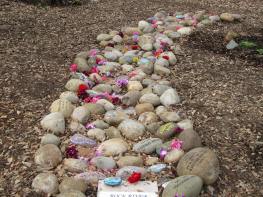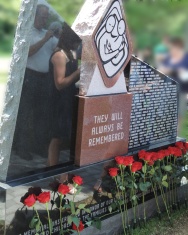You are currently browsing the monthly archive for September 2014.
News: September 26, 2014, Maine National Day of Remembrance of Murder Victims
Sister Nina Hodgkins attended the Maine Day of Remembrance for Murder Victims as proclaimed by Maine Governor Paul LePage. The new memorial wall for the state of Maine was established by the Maine Chapter of Parents of Murdered Children just last year. I was fortunate to be able to attend their ceremony with Nina last summer. Nina has been the lead for our family in getting our sister’s name Shirley “Tiny” Dianne Rollins on the new memorial wall. Other murder victims our family has known are Frank Williams and Chet Lee Worthington. Their names are included in this remembrance.
 The San Diego effort for this day of remembrance is the launching of Murder Survivors Handbook. This two and half year project is both heart wrenching and heartfelt. The book includes the commitment of many survivors who wanted to help new comers to have more information and resources than they had. Positive reviews continue to come in. A real lesson as well to those who wonder what it is like for folks to have this type of loss. It has been indeed an honor to work with so many and we all hope that it will make a difference in learning to bear this unspeakable crime.
The San Diego effort for this day of remembrance is the launching of Murder Survivors Handbook. This two and half year project is both heart wrenching and heartfelt. The book includes the commitment of many survivors who wanted to help new comers to have more information and resources than they had. Positive reviews continue to come in. A real lesson as well to those who wonder what it is like for folks to have this type of loss. It has been indeed an honor to work with so many and we all hope that it will make a difference in learning to bear this unspeakable crime.
 River of Remembrance held its annual event to coincide with this special day as well here in San Diego. It is held the Saturday before the National Day (September 25) to increase the ability for more to attend. Survivors rarely have opportunity to talk about their loved one’s life, and this event facilitates them doing so. By having rocks bearing their names and placed in a “river” and T-shirts to paint a memory of their loved one they want us all to know about, too. They would not want to be remembered just as murder victims. This event was created by the Founder of Survivors of Violent Loss, Connie Saindon, and held at the Crime Victims Oak Garden with permission of the Cara Knott family. Many agencies co-sponsor this event every year.
River of Remembrance held its annual event to coincide with this special day as well here in San Diego. It is held the Saturday before the National Day (September 25) to increase the ability for more to attend. Survivors rarely have opportunity to talk about their loved one’s life, and this event facilitates them doing so. By having rocks bearing their names and placed in a “river” and T-shirts to paint a memory of their loved one they want us all to know about, too. They would not want to be remembered just as murder victims. This event was created by the Founder of Survivors of Violent Loss, Connie Saindon, and held at the Crime Victims Oak Garden with permission of the Cara Knott family. Many agencies co-sponsor this event every year.
It’s official. Murder Survivor’s Handbook: Real-Life Stories, Tips & Resources is launched and available for purchase at Amazon.com, Barnes & Noble online, and through traditional retail outlets.

Written by Connie Saindon, MA, MFT—along with many other voices—the book is being formally released on Sept. 25, 2014, to coincide with the National Day of Remembrance for Murder Victims. [Read Connie’s essay: Remembering Our Murdered Loved Ones.]
“Many survivors and co-victims of murder asked me to write this book so those who must make this tragic journey will have a helping hand,” Saindon says. “I am saddened that there is a need for this book, but I am happy that we were able to pull this together in the interest of helping others.”
When a loved one is murdered, the survivors—the co-victims—are plunged into a head-spinning world of traumatic grief, criminal investigation, criminal justice, and the long-term consequences of violent loss. Sensational news coverage may compound the trauma of their loss.
Murder Survivor’s Handbook: Real-life Stories, Tips & Resources helps these survivors wend their way on this overwhelming journey they never chose to take.
Saindon’s professional as well as personal experience have given her a unique perspective that few others have. Not only did she learn first-hand about criminal death following the murder of her sister, she learned that she is a Survivor in every sense of the word. However, she also found that little was known about the impact of murder on survivors.
This book fills that void for the survivors, the co-victims of murder. It provides information, resources, and strategies for learning to live with the aftermath of a homicide, including safety issues, dealing with the criminal justice system, addressing the news media, and coping with traumatic grief, while preserving the memory of a loved one.
Also in the book, Survivor Writers describe their own experiences and, through their tips and suggestions, lend a helping hand to those who follow in their footsteps.
The book also encourages the readers to write down their own feelings and experiences as they take this journey no one ever wants to take, but in which they had no choice.
The Foreword to the book is written by Edward K. Rynearson, MD, Medical Director, Separation and Loss Services Program, Virginia Mason Medical Center in Seattle, WA, and the author of Retelling Violent Death.
In prerelease sales, the book became a Hot New Release at Amazon.com in the Criminal Procedure Law category, and climbed onto Amazon’s Best Seller list in that category as well.
All proceeds from the sale of the book go to the Survivors of Violent Loss Program to provide books to those who may need assistance.
For bulk purchases of the book, please contact the author or Wigeon Publishing.
Praise for the book:
This handbook is the absolutely perfect tool for survivors of homicide victims and those professionals who work to support them. Through the voices of survivors, the stark realities of learning to live with homicide are clearly exposed. The incredible depth of sorrow, daunting financial impact and the long-term challenges that survivors face are effectively presented. The wealth of information contained in this handbook needs to be on the bookshelves of everyone who interacts with survivors of homicide.
—Carol Gaxiola, mother of Jasmine Gaxiola
Director/Victim Advocate, Homicide Survivors, Inc.
The book is rich in content. It is the banquet of life-sustaining information that I did not have 15 years ago.
—Marina, Survivor/Co-victim
This is exactly the book I would have loved to have had so I wouldn’t have made so many mistakes; I would have had some idea how this entire process works.
—Dayna Herrroz, Survivor/Co-victim
Peer Advocate/Violent Loss
Details:
• Nonfiction: Death, Grief, Bereavement
• Publisher: Wigeon Publishing
• Wholesale distribution: Ingram
• Size, print edition: 8.5 x 11
• Pages: 244
• Formats:
• paperback; ISBN: 978-0-9896913-0-7; $19.95
• e-book: Kindle, iBooks, Nook, Kobo, etc.; $7.99 (to be released in October)
About the Author
 Connie Saindon is a licensed Marriage and Family Therapist and among the few specialists in the field of violent death bereavement. She is the founder of the nonprofit Survivors of Violent Loss Program in San Diego, which began at the University of California-San Diego outpatient clinic in 1998. Her commitment to violent loss bereavement is related to the murder of her sister, aged 17, in 1961.
Connie Saindon is a licensed Marriage and Family Therapist and among the few specialists in the field of violent death bereavement. She is the founder of the nonprofit Survivors of Violent Loss Program in San Diego, which began at the University of California-San Diego outpatient clinic in 1998. Her commitment to violent loss bereavement is related to the murder of her sister, aged 17, in 1961.
She is author of The Journey: Ten Steps to Learning to Live with Violent Death (2008), an adaption of the Restorative Retelling Model for adult self-help and paraprofessionals. She also is a contributing author of Violent Death, Resilience and Intervention Beyond the Crises (2006).
When not pursuing her professional interests, Saindon may be found kayaking in the Atlantic or Pacific oceans, skiing, walking her dog, or taking photographs. A native New Englander, Saindon splits her time between Boothbay, ME, and San Diego, CA.
Contact
For additional information or to schedule an interview:
Connie Saindon
858-699-7700
csaindon@svlp.org
Learn more at: Murder Survivor’s Handbook: Real-life Stories, Tips & Resources
By Connie Saindon
Murder. It’s a fact of life that never goes away. Nor does murder’s impact on the survivors: those who must deal with a horrific new reality in their lives.
On Sept. 25, the National Day of Remembrance of Murder Victims, we will be reminded of this fact as survivors gather to memorialize their murdered loved ones.
Crime rates have dropped in major cities nationwide. Nonetheless, there are roughly 15,000 homicides in the U.S. each year, according to government agencies. The FBI Crime Clock estimates one person is murdered in the United States every 35.6 minutes. These statistics do not include suicide or violent deaths due to negligence or catastrophe.
In San Diego County, the murder rate in 2013 fell to 70 homicides from 110 in 2012. Even so, anything above zero is unacceptable.
Murder often gets sensational headlines in news coverage, but the survivors and the challenges they face in the aftermath of murder typically get short shrift. Yet, the murder of a loved one is a death that no one “gets over”; there is no closure. Seven to ten people are seriously impacted by each violent death, and this “collateral damage” accumulates incrementally each year. There is a potential of 150,000 murder survivors impacted each year, meaning that today millions of Americans live under this shadow of murder and violent death.
For most people, it happens to someone else, to someone else’s mother or father, son or daughter, sister or brother. Until it happens to them. Suddenly, following that phone call or knock on the door, the survivors—the co-victims—find themselves in a mind-numbing whirl of disbelief and chaos. Their world crumbles around them as they have to not only deal with their grief, but the criminal justice system, an intrusive news media, and perhaps a life-time of parole hearings. They have a new and public “murder” identity. Who they were before is changed forever.
Survivors’ questions are many: Is this true? Who did this? Are we safe? What do I do now? Who can I trust? Survivors often say: “We have been given a life sentence for a crime we didn’t commit.” Their world is shattered. They don’t know where to turn for help. The resources, while growing, are still scant.
Similar to our soldiers, many survivors are at risk for PTSD and other health problems, such as depression and substance abuse. They may be unable to return to work or school for an extended period of time. Thus, murder has a significant impact not only on individuals and families, but society as a whole.
To increase awareness of this socially important challenge, Congress designated a National Day of Remembrance of Murder Victims to be recognized annually on Sept. 25. This year, survivors throughout that nation will come together to remember and honor their loved ones. One of the key aspects in these events is that the survivors have an opportunity to talk about who their loved one was, before he or she was murdered.
In San Diego, the annual River of Remembrance event was held on Saturday, Sept. 20, at 10 a.m, at the Crime Victims Oak Garden, which was established in honor of murder victim Cara Knott. More information about the event is available at svlnetwork.wordpress.com.
__________
Connie Saindon is a murder survivor, licensed Marriage and Family Therapist, and the author of Murder Survivor’s Handbook: Real-Life Stories, Tips & Resources, which is being released on Sept. 25. She is the founder of the nonprofit Survivors of Violent Loss Program in San Diego and initiated the River of Remembrance event.

